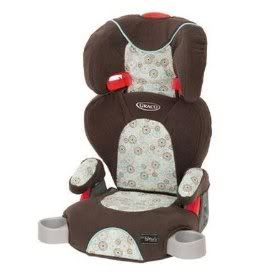Unfortunately there seems to be some confusion over guidelines and regulations for the use of each car seat. Here is a very basic rundown on carseats.
 Infant carseats (also known as "Baby buckets") are for rear facing use only. Children need to be kept rear facing for as long as possible. Rear facing is the SAFEST position for a child in the event of a collision. It protects their spinal cords, heads and necks.
Infant carseats (also known as "Baby buckets") are for rear facing use only. Children need to be kept rear facing for as long as possible. Rear facing is the SAFEST position for a child in the event of a collision. It protects their spinal cords, heads and necks. "Very young children have immature vertebrae that are still partly made of cartilage. These are soft and will deform and/or separate under tension, leaving just the spinal cord as the last link between the head and the torso. The spinal cord can stretch up to 2 inches, but ruptures when stretched more than 1/4 inch. Real-world experience has shown that a young child's skull can be literally ripped from her spine by the force of a crash."
Paraphrased from carseat.org
The bare minimum for turning a child forward facing is one year AND 20 lbs. However the AAP recommends that you use your carseat rearfacing until your child meets the maximum weight set by the manufacturer.
Read more about the safety and protection extended rear facing offers at cpsafety.com and
car-safety.org
 Forward Facing Carseats
Forward Facing CarseatsChildren who have been flipped forward facing in their carseats need to remain in a harness until they are about 4 years old and 40 pounds. If your carseat harnesses up to 65 pounds, go ahead and use it! A forward facing carseat has a harness. A booster seat does not. Look at your child objectively before you put them in a booster seat. Do they stay in their carseats without trying to escape? If you wouldn't put it past them, they're probably not ready for a booster seat.
Remember everytime your child "graduates" to the next carseat, their protection in a crash drops dramatically.
 Booster seats
Booster seatsBooster seat come in two packages: Without backs or with backs. Booster seats with backs need to be used if the top of the child ears are higher the the back of the seat top or headrest. Booster seats CANNOT be used with just a lap belt.
Booster seats should not be used unless the child weighs at least 40 lbs and is 4 years old.cpsafety.org
Like food products, carseats have expiration dates. I believe most carseats are good for 6 years, though some of the newer convertible carseats have a life of 8 years. The expiration date should be stamped on the back of the carseat shell. Carseat safety standards are constantly being changed so a carseat that was "safe" when you were a child, probably isn't safe anymore.
All carseats have height limits in addition to the weight limits, a good rule of thumb is that whenever the child's head is 1 inch below the top of the carseat shell, it's time to replace your carseat.
The weight, height and installation requirements should be found either on the side of the carseat or in the user manual. If it doubt, call the company!
Never use a carseat if you don't know it's history. A carseat needs to be replaced if it's been in an accident or has expired.
Saturday September 25 is Nation seat check day. Get a free inspection!!
No comments:
Post a Comment